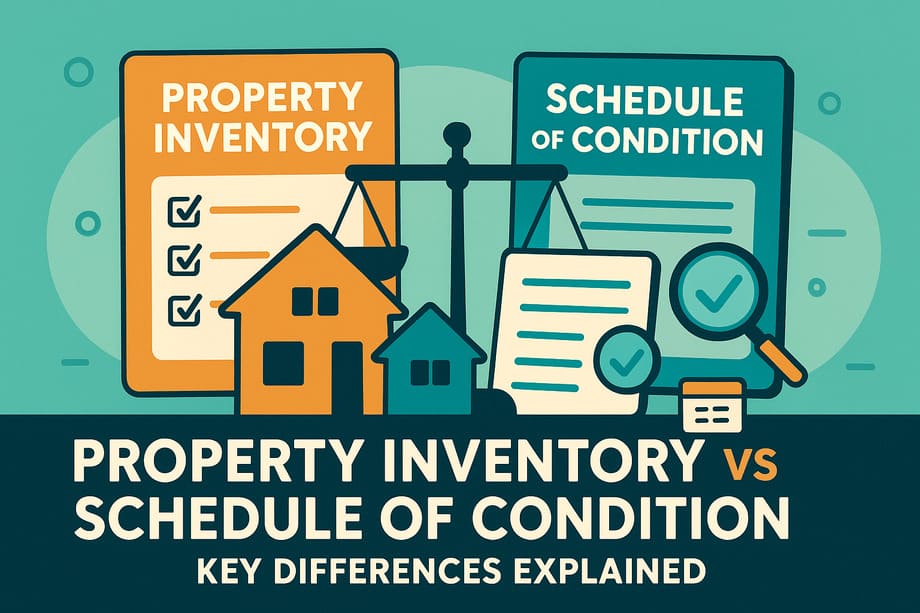Property Inventory vs Schedule of Condition: Key Differences Explained

If you’re a landlord, tenant, or property manager in the UK, you’ve probably come across the terms property inventory and schedule of condition. They sound similar, but they’re not the same. Understanding the difference between them is crucial for avoiding disputes and protecting both landlords and tenants during a tenancy.
In this guide, we’ll explain exactly what each document is, how they differ, and when you should use one or both.
What Is a Property Inventory?
A property inventory is a detailed document listing the contents and condition of a rental property at the start of a tenancy. It typically includes:
- Furniture and appliances (if furnished)
- Fixtures and fittings (carpets, curtains, light fittings, etc.)
- Condition notes (e.g. “new”, “good”, “worn”, “damaged”)
- Meter readings (gas, electric, water)
- Photos or videos as supporting evidence
Both landlord and tenant review and sign the inventory at check-in. At the end of the tenancy, the same document is used to compare the property’s condition, making it the key reference point for deposit deductions.
What Is a Schedule of Condition?
A schedule of condition is a more general record of the property’s overall state at a specific point in time. It is less detailed than an inventory and often focuses on:
- The structure of the property (walls, ceilings, floors, doors, windows)
- Decorative condition (paintwork, carpets, plaster, etc.)
- Signs of existing damage or wear
- General photographs to support the written notes
Unlike an inventory, it doesn’t necessarily list every single item inside the property. Instead, it captures the bigger picture, the overall condition of the property.
Key Differences Between a Property Inventory and a Schedule of Condition
Here’s a side-by-side comparison:
| Aspect | Property Inventory | Schedule of Condition |
|---|---|---|
| Detail level | Highly detailed (items + condition) | General overview |
| Purpose | To document contents and protect deposits | To record property state and wear/tear |
| Use case | Residential rentals (ASTs, HMOs, furnished lets) | Commercial leases, or as an add-on for residential |
| Timing | At check-in and check-out | At tenancy start (sometimes mid-tenancy too) |
| Evidence | Itemised with photos/videos | Photos of structure & decor |
| Legal impact | Central to tenancy deposit disputes | Often used in property condition disputes |
Which One Do You Need?
- Residential landlords:
Always use a property inventory. It protects you if damage occurs and ensures fairness for tenants at check-out. - Commercial leases:
A schedule of condition is more common, since furnishings are rarely included. It helps avoid disputes over repairing obligations. - For extra protection:
Many landlords use both, a property inventory for items and contents, and a schedule of condition to cover the building’s general state.
Why Getting It Right Matters
- Without an inventory, landlords risk losing deposit disputes.
- Without a schedule of condition, tenants might be unfairly blamed for pre-existing wear and tear.
- Together, they provide a comprehensive record and reduce disputes.
Pro Tip
Want a ready-made inventory template to get started?
Download our free Landlord Property Inventory Template (Word & PDF)
This template includes checklists, itemised sections, and condition notes so you don’t miss anything at check-in.
FAQs
Is a property inventory legally required in the UK?
No, but it’s strongly recommended. Without one, deposit disputes are difficult to prove.
Who prepares the schedule of condition?
It’s often prepared by a surveyor, letting agent, or landlord, depending on the tenancy type.
Can tenants dispute an inventory or schedule of condition?
Yes. Tenants should review, add comments, and only sign when they agree.
Do both documents need to be signed?
Yes, signatures confirm both parties agree on the property’s condition at the start of tenancy.
Can I use templates instead of paying for professional reports?
Yes. Templates (with photos) are sufficient for most residential lets, though professionals may be worth it for high-value properties.
How-To (for Schema)
How to decide between a property inventory and a schedule of condition:
Check tenancy type:
Residential = inventory, commercial = schedule of condition.
Decide on detail level:
Need itemised furniture/equipment? Use an inventory.
Document condition:
Use a schedule of condition if you want an overall state record.
Add photos:
Support either document with photos/videos.
Get signatures:
Ensure both landlord and tenant sign and keep copies.
Last Updated on September 9, 2025 by James Cartwright







